by René Timmermans | Oct 29, 2010 | Uncategorized
My “Domino” photo from Cuba has been selected by Photoshelter and makes me a featured photographer on their website this month.

Every month Photoshelter chooses 20 photos from several hundred submissions to display in a slideshow on their /buyer and /search sites.
The review and selection process as described by Photoshelter: “When making our selections, we look for striking individual imagery that represents our talented and diverse photographer base. Every image selected really “pops” for a different reason, and it serves as a convincing, standalone invitation for the buyer page visitor to further explore your archive.”
It is an honor for me to be selected.

by René Timmermans | Sep 16, 2010 | Photography
The autumn is approaching and the evenings are already rapidly getting darker. Temperatures are dropping and more rain is upon us. It is only one and a half month until we change the clock to winter-time. It is time to dream about wonderful summer evenings.
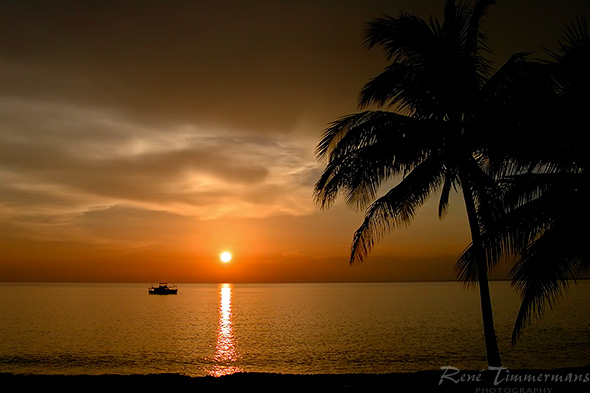
The past summer in Sweden has been great and with good weather, nothing to complain. However, when I was browsing through some old photo folders I came across images from 2002 when we spent some summer weeks in Cuba. Memories went back to the evenings we spent at Maria La Gorda, they were spectacular.
Maria La Gorda was then a small diving resort in the far west of Cuba. It was recommended by one of my business contacts, who had been there recently. To get to Maria La Gorda was not the easiest. In a five hour drive a taxi drove us over bad roads and in high speed towards paradise.
At the time Maria La Gorda existed of nothing more than some simple cabins near the beach (see photo below). During the day there was little more to do than sunbathing, snorkeling or joining a boat ride for some scuba-diving, and that was just what we did.
During the evenings we could enjoy the sunset, walk over the beach and relax with a Cuba Libre in one of the many beach chairs under the palm trees. Is there anything more one could wish for?
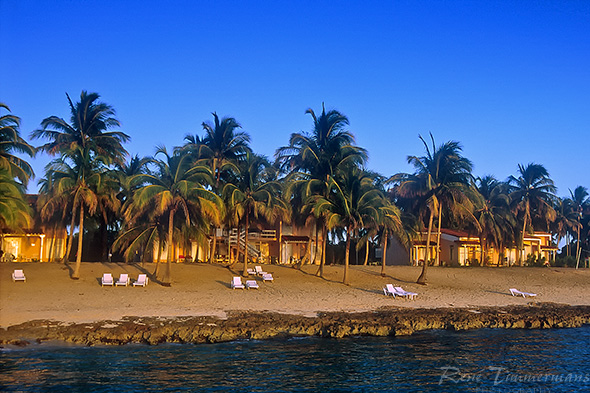
I remember that holiday as the first one with a digital camera, a Nikon Coolpix E885, ancient by now, and with only 3.2M pixels. The first photo in this post was taken with it.
The second photo in this post was taken with my Nikon F801s, that I had bought back in 1992, and was thus 10 years old, but reliable as always. I mostly used positive film at the time and would scan it in with a 35mm scanner.
The above photos, as well as some other newly uploaded photos, including bad weather over Maria La Gorda, can be viewed in the Cuba gallery.
by René Timmermans | Nov 9, 2009 | Photography
As mentioned in a previous post, while I was in Cuba I spent a lot of time on the Malecón, the 8 km long boulevard along the coastline of Havana. It turned out to be my favorite place to photograph and to get in touch with the locals.
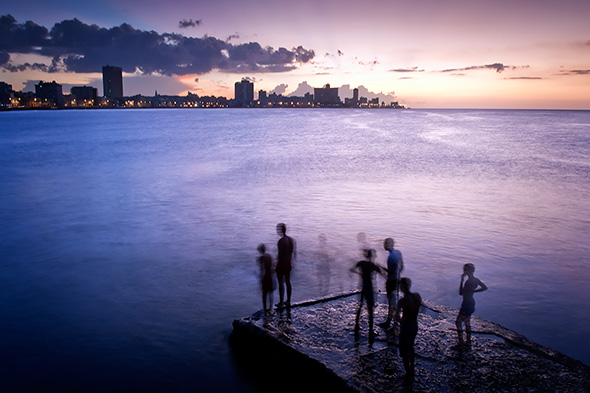
Evening ghosts at the Malecón.
Especially in the evenings the long boulevard gets busy with tourists and locals. The sun sets just behind Vedado creating amazing and colorful panoramas. The local youth comes out to swim from the rocks and platforms when the sea is calm. This creates some fine photo opportunities.
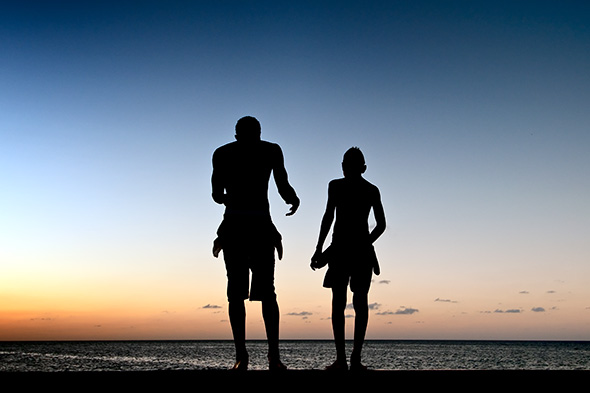
Going for an evening swim.
Many fisherman come to the Malecón with their equipment to catch an evening meal.
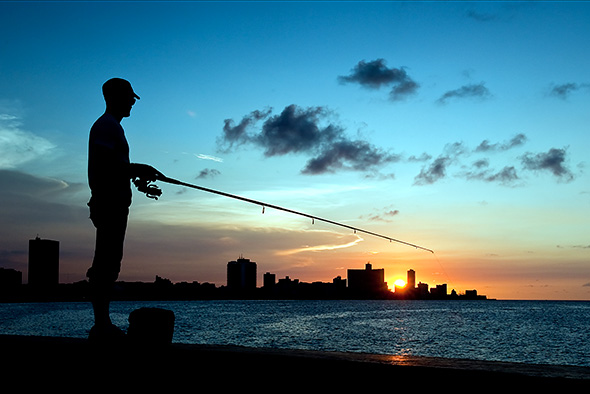
Fisherman at sunset.
One evening I got in touch with a young man selling baseball caps to make a living. His story was kind of sad. He claimed to have been part of Cuba’s national baseball team, traveled and lived in Canada for a year to play baseball and learn English. When he had returned back on Cuba he was eager to leave again as he enjoyed live in Canada better and he decided to try and go to the US.
As this is not possible to do for Cubans, together with two friends he arranged for a small boat and they tried to flee the country and were heading for Florida. Shortly after they had left the shore they were captured by the Cuban coastguard and sent to jail for three years. He was kicked out of the national baseball team and as he expressed it: “I screwed up and threw away the biggest opportunity I was given in life”.
by René Timmermans | Oct 30, 2009 | Photography
…it does not get any better than that!
This week I returned from a three week trip to Cuba. I traveled from Havana to Santa Clara, Trinidad and Cienfuegos. All went well and I had an enjoyable stay. Photography wise I could have limited my traveling to Havana and Trinidad, as the people and environments were strongest to photograph there.
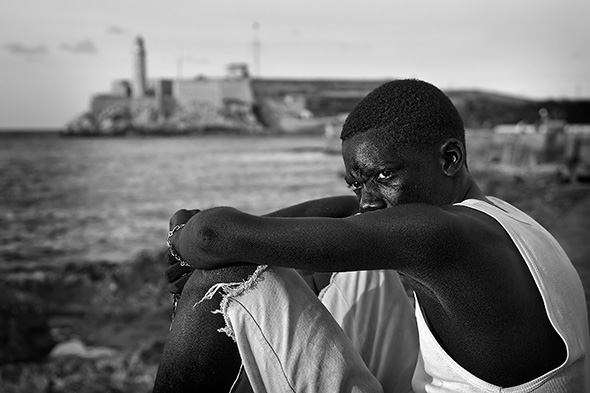
Hanging out at the Malecón.
The Malecón, the 8 km long boulevard along the coastline of Havana, is a wonderful place to stroll along and watch people hanging out, swimming and fishing. I spent much time on the Malecón on early mornings and sunset evenings.
The people of Cuba have in general no problem with taking photographs of them. They are very friendly and were always ready for a chat to practice their English or help me with my Spanish skills. Their curiosity is enormous, and they are always interested to know where you come from, what your name is, what you think of Cuba and of course if you are interested to buy cigars.
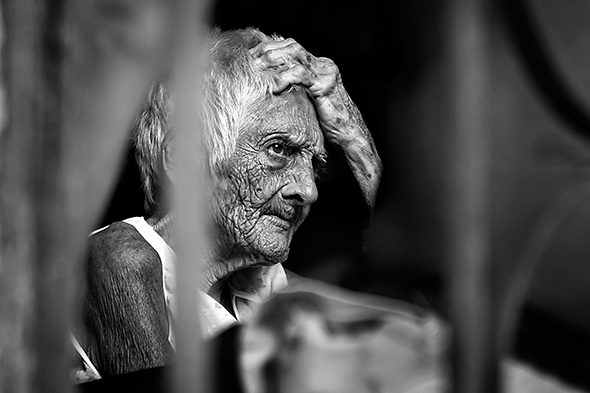
An old woman over-thinking her daily worries.
Compared with my first trip to Cuba in 2002 I can see many differences. Obviously the Dollar has been exchanged for the Euro. The number of old American cars has decreased and been replaced by new Korean cars. There are more modern shops, supermarkets and fancy restaurants, although for the local people there is still a limited possibility to purchase goods (an average pension is about 9 Euro a month and a young cigar roller earns about 6 Euro a month.) The mobile network works well through big part of the country, but not many locals use a mobile phone. Internet access is widely available for foreigners in hotels or the Etecsa (energy and communications company) offices.
What has remained is the charm. It is enjoyable to walk the streets in the evening and watch the people play a game of chess or domino, while others watch and throw in various advices. And sometimes an odd stranger walks by, dressed in cameras, but that does not take away the concentration on the domino stones…
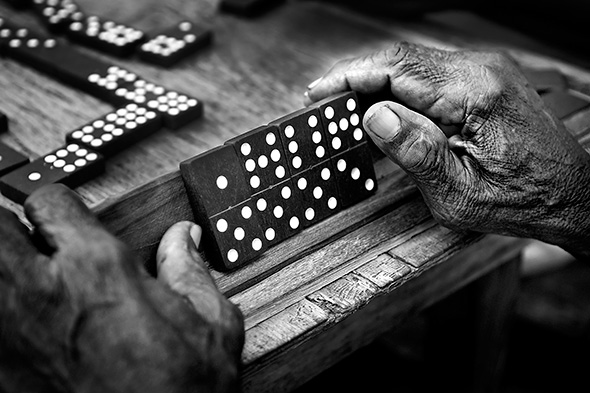
Domino is the national game.
If you are interested, my website is updated with new Cuba galleries (www.renetimmermans.com), but more will come on this blog in the coming weeks as well…
by René Timmermans | Oct 1, 2009 | Photography
As you probably can imagine after reading my previous post, I am currently in full preparation for my Cuba trip.
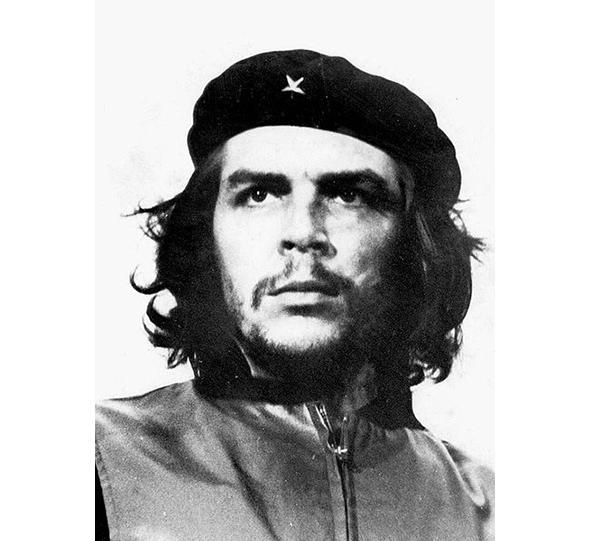
Photo: “Guerrillero Heroico” by Alberto Korda
The can-not-live-without Cuba Lonely Planet Guide book is bought. I actually have had this for a while in order to detail plan my travel plans while in the country. It is amazing how much (practical) information these guide books contain. I have had these guide books with me on almost all my travels and this collection takes quite some space on the bookshelf by now.
My tourist visa was arranged last week, which went very quick as I could wait for it while at the Cuban consulate here in Stockholm. Usually I have to wait a few days when I apply for a visa as I have a Dutch passport, but apply with the consulates in Sweden.
In the last month I have tried to brush up my Spanish skills by following a Rosetta Stone course. It is fun to do, but I doubt if this is the best course as you just look at a bunch of photos and do not get any explanation what so ever. With me on my iPod Touch I have the Michel Thomas and Pimsleur Spanish courses as well, so I will be able to continue studying while traveling. Lets see how much that will happen though…
But by far the most pleasure I have during the preparation, is with researching on Ernesto “Che” Guevara. There is an incredible amount of information available about him on the net. The most well known piece of documentation is without a doubt the photo from Alberto Korda (see on top of this post), which is considered the most famous photo in the world… ever!
During last week I watched “The Motorcycle Diaries“, a movie about Guevara traveling through South America with his friend, Alberto Granado, on a motorbike. During this journey Guevara gets shocked by the amount of injustice he sees and this lays the ground for his future efforts to improve the world by participating in and starting revolutions. That part of his life is well documented in the movie: “Che, part one“, which is about the Cuban revolution and “Che, part two“, in which Guevara leaves from Cuba to start a revolution in Bolivia, where he sadly gets captured and executed by a group of CIA trained agents. Although I am not an expert on Guevara or Cuba, in my view the movies give a good insight on his personality. “Che, part one” gives a good insight in the reasons and goals behind the Cuban revolution and helps me better understand the Cuba we see today.
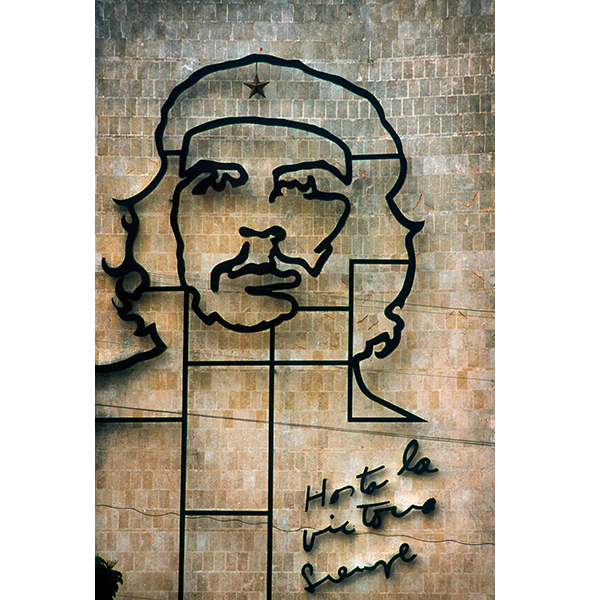
.
Above is a photo I took in 2002 of the icon Ernesto “Che” Guevara on Plaza de la Revolución.












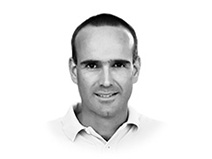


Recent Comments